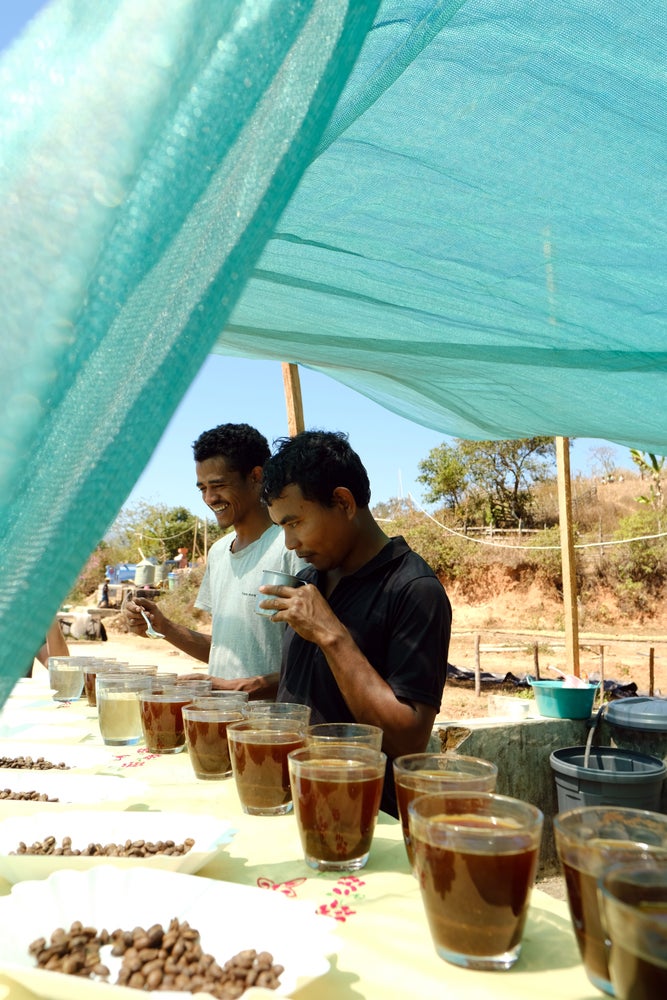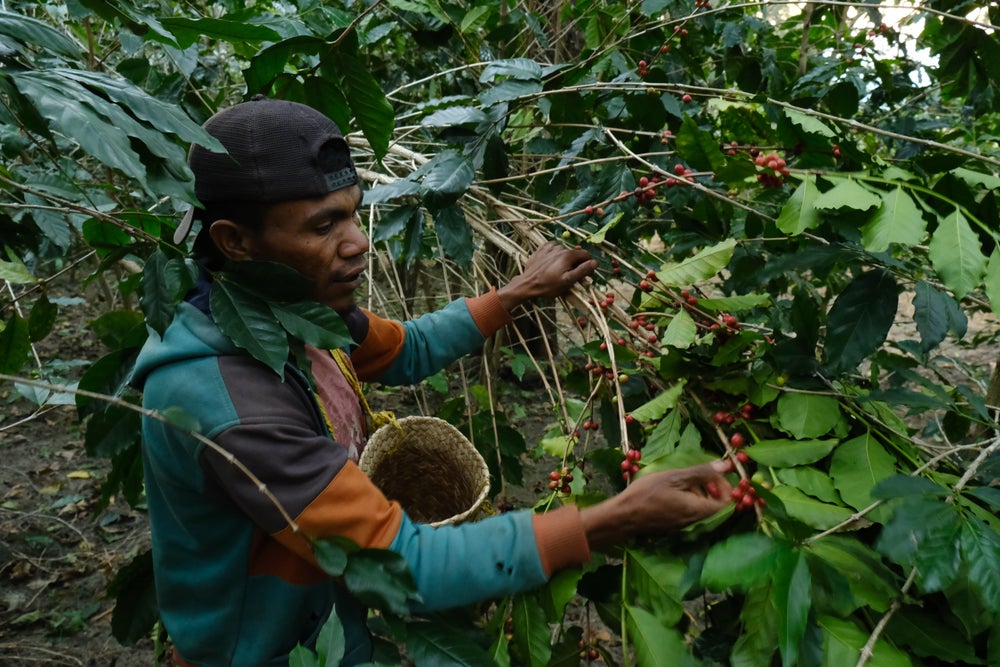

Timor-Leste
Timor-Leste has had a long and tumultuous history that has seen colonization, several occupations, independence and a long and difficult path to peace. Coffee has played a role in Timor-Leste’s economy since the beginning of the country’s modern history.
Details
- Place In World Production:
- #37
- Average Annual Production:
- 88,000 (in 60kg bags)
- Common Arabica Varieties:
- Catimor, Typica, Timor Hybrid (Hibrido de Timor)
- Key Regions:
- Ermera | Ainora | Aileu | Same
- Harvest Months:
- May -September
Offers
Coffee and Conflict
When Portuguese traders arrived in Asia Pacific in 1520, abundant forests of fragrant sandalwood attracted traders for the high price it fetched on the global market. High demand for sandalwood—and the riches that came with selling it—was a driving cause for colonizing the island of Timor and many other islands in Asia Pacific.
Coffee is believed to have been first cultivated on Timor way back in the 17th century. From 1613 until 1860, the western half of the island was controlled by the Dutch. Control of the eastern half was under contention by the Portuguese and the Dutch until the Portuguese won out in 1860. Funnily enough, it’s still unknown as to which Colonial power first commercialized coffee production on the island, but even today the island of Timor remains split between two sovereign states, with Indonesia governing the West and Timor Leste (East Timor) the east.
Sadly, the beautiful Island has experienced several periods of political turmoil and the nation’s coffee industry has ebbed and flowed in close correlation to volatility in the region. During the 1974 Portuguese revolution and after years of neglect from the Portuguese government, East Timor was effectively abandoned as a Portuguese colony. Several months of internal political dispute prompted an opportunistic Indonesian invasion that lead to hugely controversial and violent occupation. After years of civil unrest, guerrilla warfare and mounting international pressure, Indonesia withdrew from the East and in 2002, East Timor became the first sovereign state of the 21st Century.
Coffee History
Coffee has played a repeating cameo in Timor-Leste’s history, and it only continues to grow more visible and important to the economy as time goes on. Although it is unknown whether coffee production started first in the West or the East, it is clear that the crop on the eastern side of the island was introduced by early Portuguese traders. After years of extracting sandalwood for trading abroad, wild-growing sandalwood forests were dwindling and, in search of another source of income, Portuguese colonialists established coffee plantations. As early as 1860, coffee accounted for at least 50% of the total export value from Timor-Leste. Unfortunately, most of this production was owned and overseen by a select group of Portuguese landowners. While local communities were frequently hired for harvesting, they saw very little profit from coffee.
After the Portuguese landowners withdrew and Indonesia annexed Timor-Leste in 1976, the focus on coffee diminished and production in Timor-Leste shrunk considerably. After regaining independence in 2002, the coffee sector was quickly rebuilt as a means of economic development. With the help of international aid, coffee soon became the country’s only cash crop. Today, coffee accounts for about 80% of total export revenue.
The Timor Hybrid
The name “Timor-Leste” may sound familiar because the word “Timor” is also the name of a widespread coffee variety. “Timor” also appears in other varieties like “Catimor” or “Sarchimor”, names that, like their coffees, are hybrids of the two parent plants’ names.
It’s no coincidence the name “Timor” is so ubiquitous in our variety names, the first widely studied hybrid was found growing in Timor-Leste in the 1920s. The hybrid was the product of one Robusta and one Arabica plant mating. The resulting plant, which soon came to be known as Hybrido de Timor, after the island on which it was found, took on traits from both parent plants. The Timor hybrid was resistant to coffee leaf rust (CLR), like its Robusta parent, but also had higher cup quality, thanks to its Arabica parent.
The discovery of the Timor Hybrid coincided with the expansion of CLR across most of Central and East Africa and Asia. Since CLR spores can remain in soils long after the infected plants die (making it difficult to replant the same varieties), new CLR-resistant hybrids became essential to revitalizing coffee production in these regions. Since Timor’s discovery, scientists have bred countless other hybrid varieties to combat the CLR epidemic and the older Timor variety has played a central role in continuing to breed new resistant varieties with good cup quality, such as Marsellesa, Obata and Oro Azteca, to name a few.
Coffee Production Today
Today, coffee is the second most valuable export in Timor-Leste and is exceeded only by oil. A full third of the country’s population depends on coffee as their primary source of income.
Most of the harvest is Arabica. A small amount of Robusta is grown at lower altitudes, but generally, Timor-Leste’s mountainous terrain lends itself well to high altitude Arabica cultivation.
There are six major coffee growing regions in Timor. While these regions are all very close if you map them as the crow flies, poor infrastructure and mountainous terrain stretches these small distances over hours of driving.
Most of the coffee we buy comes from Letefoho, a subregion in the municipality of Ermera, which is itself well-known as the region that produces Timor-Leste’s highest quality coffees. Letefoho has the highest altitudes in Ermera and coffee farms lie between 1,300 and 1,900 meters above sea level.
This combination of high altitude, rich soil and superb climate, when paired with a focus on increasing farmer know-how and improving infrastructure, has—and will continue to—produce incredible coffees.
Improving Quality for the Future
While coffee production in Timor-Leste continues to expand and quality continues to improve, the climate presents difficulties. The arid weather and short rainy season make it difficult for coffee cherry to grow. On top of contrarian weather, the low nutrient-content in the soil and negligible access to fertilizers and pesticides makes it more difficult for coffee trees to thrive. The average farmer currently collects only about 500 grams of green coffee per tree (2-3 kg cherry).
Timor-Leste’s coffee industry is prevailing in the face of these difficulties. Both quality and productivity are rapidly increasing. Small changes are increasing coffee quality by leaps and bounds, while several programs, funded by NGOs, are working to fundamentally change coffee harvesting and processing in the country.
The government is also playing a role in improving coffee quality by investing in infrastructure, such as new roads, that will make transporting both cherry and parchment easier. Timor-Leste is poised to be a reliable producer of good quality and versatile coffees.
We’re proud to be active in Timor-Leste. We work alongside farmers, cooperatives and agricultural extension officers to help farmers increase yields and quality. Our goal is to work with our partners to help farmers reach an average yield of 2.5 kilograms per tree while also increasing quality. Higher production and higher quality will mean larger incomes for farmers.